Contents
List of Figures
Guide
Pagebreaks of the print version
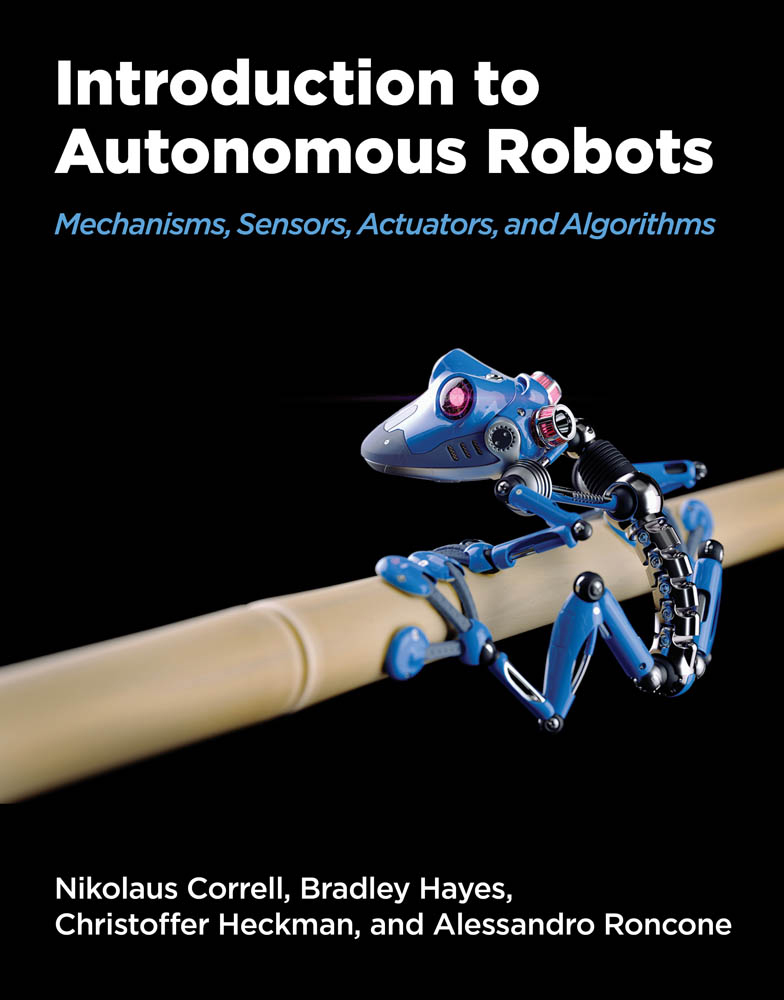
Introduction to Autonomous Robots
Mechanisms, Sensors, Actuators, and Algorithms
Nikolaus Correll, Bradley Hayes, Christoffer Heckman, and Alessandro Roncone
The MIT Press
Cambridge, Massachusetts
London, England
2022 Nikolaus Correll, Bradley Hayes, Christoffer Heckman, and Alessandro Roncone
This work is subject to a Creative Commons CC-BY-NC-ND license.
Subject to such license, all rights are reserved.
Copyright in this monograph has been licensed exclusively to The MIT Press, https://mitpress.mit.edu, which will be releasing the final version to the public in 2022. All inquiries regarding rights should be addressed to The MIT Press, Rights and Permissions Department. Source code of this book is licensed under a Creative Commons Attribution-NonCommercial-NoDerivatives 4.0 International (CC BY-NC-ND 4.0). You are free to share, copy, distribute, and transmit sources under the following conditions: You must attribute the work to its main author, you may not use this work for commercial purposes, and if you remix or modify this work you may not distribute the modified material. For more information, please consult https://creativecommons.org/licenses/by-nc-nd/4.0/.

The MIT Press would like to thank the anonymous peer reviewers who provided comments on drafts of this book. The generous work of academic experts is essential for establishing the authority and quality of our publications. We acknowledge with gratitude the contributions of these otherwise uncredited readers.
Names: Correll, Nikolaus, author.
Title: Introduction to autonomous robots: mechanisms, sensors, actuators, and algorithms / Nikolaus Correll, Bradley Hayes, Christoffer Heckman, and Alessandro Roncone.
Description: Cambridge, Massachusetts: The MIT Press, [2022] | Includes bibliographical references and index.
Identifiers: LCCN 2022010036 (print) | LCCN 2022010037 (ebook) | ISBN 9780262047555 (hardcover) | ISBN 9780262372947 (epub) | ISBN 9780262372954 (pdf)
Subjects: LCSH: Autonomous robots.
Classification: LCC TJ211.495.C67 2022 (print) | LCC TJ211.495 (ebook) | DDC 629.8/932dc23/eng/20220801
LC record available at https://lccn.loc.gov/2022010036
LC ebook record available at https://lccn.loc.gov/2022010037
d_r0
For
Arthur, Tatiana, Benedict, and Silvester,
David, Leonardo, and Lily,
future robot users.
Contents
List of Figures
A windup toy that does not fall off the table using purely mechanical control. A flywheel that turns orthogonal to the robots motion induces a right turn as soon as it hits the ground once the front caster wheel goes off the edge.
Ants finding the shortest path from their nest (bottom) to a food source (top). From left to right: The ants initially have equal preference for the left and the right branch, both going back and forth. As ants return faster on the shorter branch, there will be more pheromones present on the short branch once a new ant arrives from the nest.
A simple maze made from cardboard, wood, or LEGO bricks with one or more charging stations. Locations in the maze are marked with unique markers that can be recognized by a simple robot.
Power consumption versus speed for various means of locomotion. Source: Siegwart (2011) and Todd (1985).
From left to right: Manipulators with one, two, three, and four DoFs using a combination of rotational and prismatic joints.
From left to right: Statically stable robot; dynamically stable inverted pendulum robot; static and dynamically stable robot (depending on configuration).
Pitch, yaw, and roll around the principal axis of an airplane.
From left to right: Manipulators with one, two, three, and four mechanical DoFs. The Cartesian DoFs needed for the end-effector to move in a plane are the vertical displacement of the end-effector with respect to the base, its horizontal displacement, and its orientation.
A coordinate system indicating the direction of the coordinate axes and rotation around them. These directions have been derived using the right-hand rules.
Two nested coordinate systems (also referred to as frames of reference).
The top graph shows a coordinate system {B} with position given by AP and orientation given by  , B, and B. The bottom graph shows the projection of the unit vector
, B, and B. The bottom graph shows the projection of the unit vector  onto the unit vectors that span coordinate system {A} after moving {B} into the origin of {A}. As all vectors are unit vectors, AB = ABcos = cos.
onto the unit vectors that span coordinate system {A} after moving {B} into the origin of {A}. As all vectors are unit vectors, AB = ABcos = cos.
A simple 2-DoF arm.
Example of selected Denavit-Hartenberg parameters for three sequential revolute joints. The z-axes of joint i and i + 1 are parallel, which results in i = 0.
Distance to (x = 1,y = 1) over the configuration space of a two-arm manipulator. Minima corresponds to exact inverse kinematic solutions.
Configuration or joint space (left) and workspace or operational space (right) for a non-holonomic mobile robot (top) and a holonomic manipulator (bottom). Closed trajectories in configuration space result in closed trajectories in the workspace if the robots kinematics are holonomic.
Mobile robot with local coordinate system {R} and world frame {I}. The arrows indicate the positive direction of position and orientation vectors.
Left: Differential-wheel robot pivoting around its left wheel first and its right wheel next. For infinitesimal motion, it is possible to decouple the left and right wheel to simplify computation of the forward kinematics. Right: A wheel with radius r moves by r when rotated by degrees.
Left: Kinematics of carlike steering and the equivalent bicycle model. Right: Mechanism of an Ackermann vehicle.
Omnidirectional robot using Swedish wheels in different configurations. Each wheel has two velocity components: speed perpendicular to the wheels main axis and speed of the rollers. Arrows on the robot body indicate the resulting direction of motion and rotation.
Difference in desired and actual pose as a function of distance , bearing , and heading .
Velocity (top) and force (bottom) manipulability ellipsoids for a 2-DoF planar arm (n = m = 2). In this simple 22 case, the ellipsoids collapse to simple ellipses (whose major and minor axes are drawn by a dotted line).
Cross-section from above showing an idealized two-finger (left) and three-finger (right) gripper holding a cylinder.
Left: Coulomb friction relates normal to tangential reaction forces that are required to overcome friction, here shown for rightward motion. Right: Friction cone for point forces. As long as the force is within the cone, the finger will not slip.
From left to right: ideal force exerted via a single point of contact, forces exerted through an area of contact, contact area increasing from pressure and conforming with the surface. Remaining degrees of freedom are indicated by arrows.
Simple 1-DoF grasping mechanism that relies on friction to grasp objects with a wide variety of sizes (center, right). The mechanism has only one moving part that presses the object against a passive finger.


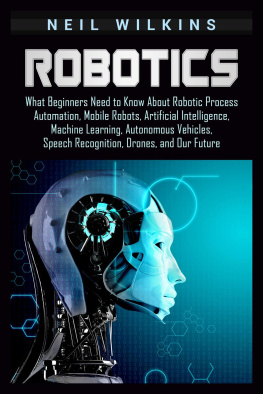
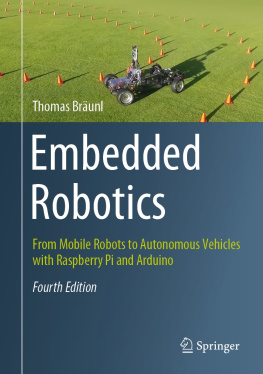
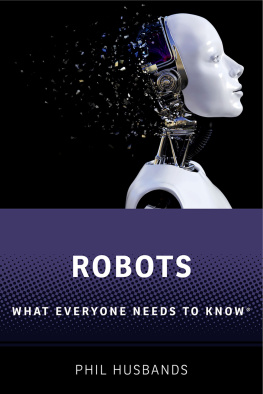
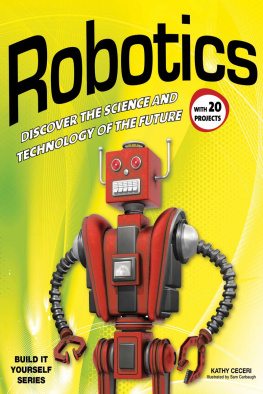
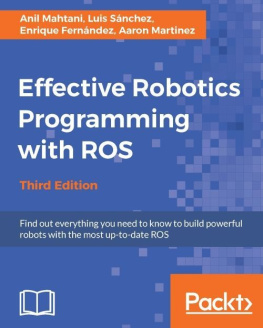



 , B, and B. The bottom graph shows the projection of the unit vector
, B, and B. The bottom graph shows the projection of the unit vector  onto the unit vectors that span coordinate system {A} after moving {B} into the origin of {A}. As all vectors are unit vectors, AB = ABcos = cos.
onto the unit vectors that span coordinate system {A} after moving {B} into the origin of {A}. As all vectors are unit vectors, AB = ABcos = cos.